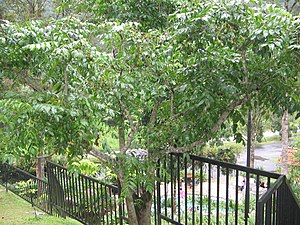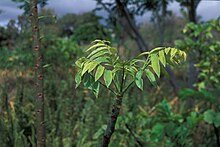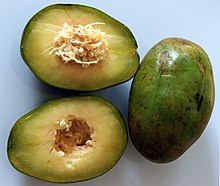Golden plum
| Golden plum | ||||||||||||
|---|---|---|---|---|---|---|---|---|---|---|---|---|

Golden plum ( Spondias dulcis ) |
||||||||||||
| Systematics | ||||||||||||
|
||||||||||||
| Scientific name | ||||||||||||
| Spondias dulcis | ||||||||||||
| Parkinson's |
The golden plum ( Spondias dulcis ), also known as Ambarella , is a type of plant from the genus Mombin plums ( Spondias ) in the sumac family (Anacardiaceae). It is a fruit tree widespread mainly in Polynesia .
description

Vegetative characteristics
The golden plum grows as a semi-evergreen tree . The size specifications vary greatly depending on the author: They range from 6 to 12 meters in height with 45 centimeters in diameter at chest height (BHD) to 30 meters in height and 80 centimeters in BHD. The crown is usually symmetrical and made up of a few strong branches. The bark of the trunk is relatively smooth, initially green, later gray-brown. The straight-grained and dull wood has a whitish to gray sapwood and a gray-brown core.
The alternately arranged, stalked leaves are pinnate unpaired and are 20 to 60 centimeters long. The leaf stalk becomes up to 15 centimeters long. The 9 to 25, under hand, lighter and slightly shiny pinna leaflets are each gestielt short, elliptical, or egg-shaped to eilanzettlich, oblong, and at a maximum width of 3.5-5 cm to about 7.5-15 cm. The thickened leaf margin is (removed) serrated, sawn and slightly rolled. The tip is rounded or pointed to pointed, the veins are pinnate, with a partly thickened central artery and a lighter upper side. At the beginning of the dry and cool season, the leaves fall off, whereupon new shoots begin after a few weeks.
Generative characteristics
The flowers are terminal or axillary, 20 to 30 centimeters long, almost bare panicle inflorescences . In the inflorescences there are mostly hermaphroditic and protandric flowers, female and male can occur. There are cover sheets on the spindle and on the side axes .
The short-stalked, green-white flowers are five-fold with a double flower envelope . The chalice is small with five small, triangular lobes. The flowers have up to ten stamens , the five white petals are up to 3 millimeters long and spread out to the back. There is a yellow disc and on it sits the upper ovary with five conical pistils .
Round to ellipsoidal drupes with a length of 5 to 10 centimeters and a weight of up to 500 grams are formed. The porous and brown stone core, which is up to five pods, has no (normal) endocarp , but one with white, bony and fringed, pointed outgrowths. One to five seeds sit in the hard, 2.5 to 3.7 centimeter long stone core. The fruits ripen throughout the year. The fruits stand in pairs to twelve on hanging fruit stands. The skin is thin, firm and initially green. When ripe, the skin and pulp turn orange-yellow. The mesocarp becomes juicy, sour and has a pineapple-like taste. When the fruit becomes soft, it gets a musky odor. The pulp has the following composition: 0.5 to 0.8% protein , 0.3 to 1.8% fat , 8 to 10.5% sugar , 0.85 to 3.6% raw fiber.
Occurrence
The natural occurrence of the golden plum is in Polynesia , from New Guinea in the west via Fiji and Samoa to the Society Islands in the east.
It is cultivated in the tropics and subtropics of the Old World ( Malaysia , India , Indonesia , Sri Lanka ), less often in America ( Jamaica , West Indies , Venezuela , Brazil ).
The golden plum thrives in fresh locations with high humidity.
use
The focus is on the use as fruit . The green fruits fall from the tree and are stored until they are ready for consumption ( climacteric fruits). The sweet and sour stone fruits are either consumed fresh or processed into juices and jams . Jelly is made from unripe fruits ( pectin content about 9.8%). In Southeast Asia , the young leaves are also eaten raw because of their sour taste.
The wood works well for making veneers , plywood, and shingles .
literature
- Peter Schütt, Ulla M. Lang: Spondias dulcis . In: Peter Schütt et al .: Trees of the Tropics . Nikol, Hamburg 2006, pp. 597-600. ISBN 978-3-933203-79-3
- J. Mitchell, DC Daly: A revision of Spondias L. (Anacardiaceae) in the Neotropics. In: PhytoKeys. 55, 2015, pp. 1–92, at pp. 22–25, fig. 2, 15, 16, 20, doi: 10.3897 / phytokeys.55.8489 , online at researchgate.net.
Web links
- Spondias dulcis at Useful Tropical Plants.




